
Boating Basics Online is reader-supported. When you buy via our links, we may earn a commission at no cost to you. Learn more

How to Paint a Sailboat? – A Step-by-Step Guide
Written by J. Harvey / Fact checked by S. Numbers
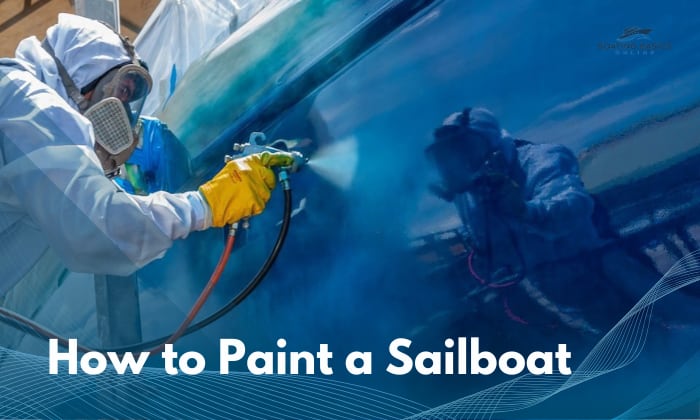
Painting a sailboat hull not only lets you save money, but it can also be quite gratifying. Plus, learning how to paint a sailboat can be likened to taking that one important step of truly claiming your vessel as your own. I mean, they’re our darlings, right?
This simple guide teaches you how to paint the hull of a boat, including a sailboat’s. Overall, it’s not hard to grasp – just a bit tiring, and plenty of waiting is involved.
Table of Contents
Prepare the Following
Step 1. give the sailboat a thorough cleaning., step 2. start sanding the hull’s surface., step 3. prepare the primer, then apply it., step 4. prepare the paint, then start applying the topcoat and antifouling coat., the importance of painting your sailboat, how often do i need to paint my sailboat, some best paints to use for a sailboat, safety tips for painting.
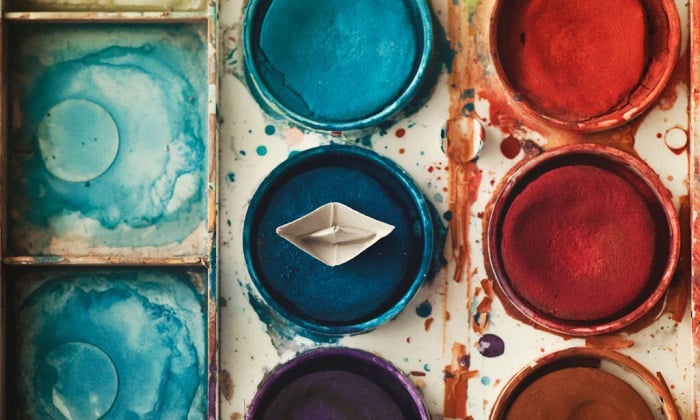
- Marine-grade paint
- Primer (epoxy recommended) and hardener
- Sandpaper (80-grit, 220-grit, and 400 grit)
- Cleaning cloth
- Masking tape
- Roller (or paint sprayer)
- PPEs such as gloves, a coat, and a respirator
Choose a workspace with good ventilation to avoid exposing yourself to fumes, which have many detrimental but highly avoidable side effects. Painting the boat on its trailer on a clear, dry day and positioning it so the paint won’t get direct sunlight exposure are ideal.
Practical Steps for Painting a Sailboat
This guide works well for fresh paint jobs and even if you’re repainting the boat.

Any dirt, debris, and grease should be taken care of in any sailboat paint job. Check for debris and algae clinging to the hull and the sailboat deck, and just use the brush and cloth to get it off.
Double-check parts of the keel because mud and seaweed tend to stick to it the most. If there are barnacles present, you may have to power wash them or any stubborn green stuff you encounter.
Dip the sponge in a mix of boat soap and water, then start scrubbing any stains. Afterward, give the sailboat a good rinse. Wait for it to dry.
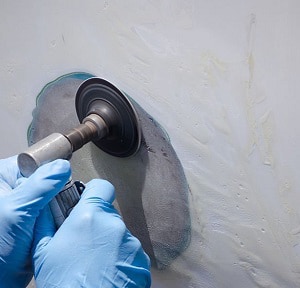
Put on your respirator and coat. Use an 80-grit or 100-grit to roughen the surface and remove any lingering trace of old paint by scrubbing in circular motions.
Then, grab the 220-grit to smoothen the surface more. That said, an 80-grit or 40-grit paired with a sander will do just as well, based on my experience every time I repaint a fiberglass boat .
You’d want the surface to be as even and smooth as possible before applying the first coat.
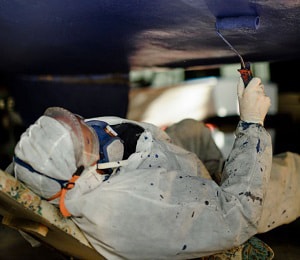
The epoxy primer helps to ensure that the paint will adhere well, too, so I recommend you don’t skip it. Epoxy also acts as a good sealant and prevents cracking and rust.
Before you apply it, put some masking tape over the areas of the hull that you don’t want the coats to go over. It will ensure even coats, too.
Every epoxy primer and hardener combination is different in one way or another. As such, follow what the manufacturer recommends when mixing. Be mindful of how quickly the mixture hardens.
Once you’re done with that step, use the roller to apply even coats of it over the whole surface of the hull. Depending on the size of your boat, this may take a while and can be tiring, so I suggest you ask for help.
Done? It’s time to wait a day to apply another layer. The next day, you can either apply another coat of primer (up to 4 coats is great) or proceed to the painting part.

Mix the paints according to the instructions.
You need to make sure the primer has dried before painting. I suggest two layers of topcoat followed by two equal coats of antifouling paint. But you can also skip to the antifouling paint immediately – your boat, your choice.
- Be sure to pick a good marine-grade paint like TotalBoat’s Alumipaint AF or Interlux’s Fiberglass Bottomkote Aqua. Better yet, you can just head to your local marine shop and ask for recommendations (trust me, they know their sailboat paint best).
- We’re not exactly doing something artsy here, like making an easy sailboat painting with acrylics. You want coats that can take a beating, so choose marine grade only.
Once you’re ready to work, use a roller or a sprayer to apply the paint. Personally, I’d suggest the latter choice because if you spray paint a boat, you’ll get a sleeker, more attractive finish, although it requires some skills.
Therefore, if you’ve never handled a sprayer, the best way to paint a boat would be with a roller. Here are some tips to ensure the best results:
- Pour the paint into the t
- Slightly dampen the roller with clean water.
- Lightly dip the roller into the paint so that no more than half of it is submerged.
- Run the roller on the paint tray’s ramp a few times to evenly distribute the pigment.
- Run the roller from the top to the bottom of the hull. Make sure you apply even pressure as you do so. Remember: the strokes should be parallel and uniform; under no circumstance should you change the stroke to a different pattern.
- Use a paintbrush to access cavities and holes on the hull that your roller can’t reach.
- Apply the suggested number of coats for each type of paint, taking care to sand with the 400-grit or higher with each However, make sure you confirm that it’s recommended by the paint’s manufacturer.
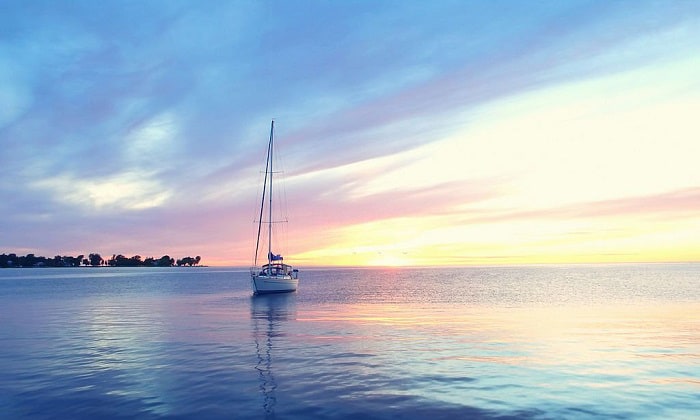
- The first is aesthetics. How can your gaze possibly not be arrested by an exquisitely painted sailboat sailing in the distance? It’s an automatic postcard image.
- Secondly but just as important (if not more), you’re protecting your baby from damage, barnacles, rot, and other nasty things, extending its life and boosting its value.
- It exercises your creativity. Try out some sailboat paint schemes available on sites like Pinterest, and you’ll know what I’m talking about.
I’ve certainly tried one or two of these ideas myself, but not on a skiff and jon boat that I made from scratch. My wife and buddies were positively mesmerized.
- Much like how videos on YouTube showing easy boat acrylic painting puts my mind at ease, I can say the same for when I’m painting sailboat hulls.
A lot of my friends who love to sail, fish, and paint sailboats on canvas say the same since they’re often more than willing to stop by and lend a helping hand during my paint days. We exchange sailboat painting ideas occasionally, and they like the method I’ve shared here.
As such, painting boats can be a way to relax your mind and help you connect with like-minded people. You may also learn helpful tips regarding sailing and boat maintenance along the way.
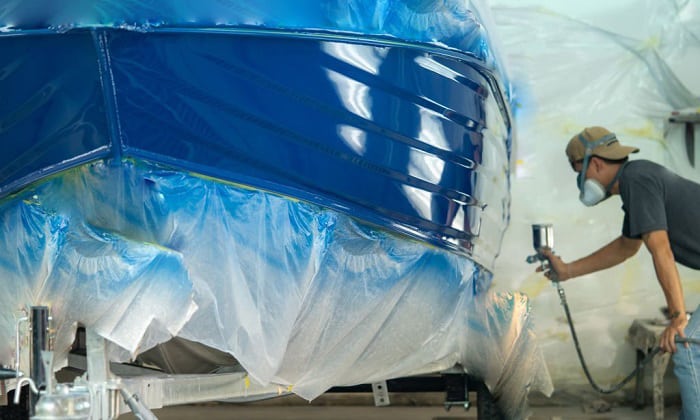
You need to paint your boat every year if you let it sit in the water all the time and the vessel shows signs of degradation.
That said, if you paint your sailboat with high-quality products, such as marine-grade paint, the coating can last for as long as 10 years, especially if you’re extra careful with your boat and have proper storage for it.
Besides the two brands I mentioned above, you can also try antifouling paints by Rust-Oleum. I just rotated between TotalBoat, Rust-Oleum, and Interlux because these three provided the best results among the sailboat paints I tested.
Rust-Oleum’s Topside Paint paired with the brand’s fiberglass primer work well with fiberglass hulls. But I can say the same for TotalBoat’s Topside Paint. To me, it’s really just whichever of the three is available on my local marine shop’s shelf. Besides choosing the right paint, you may also ask yourself how much it costs to paint a boat. Is it worth it? Check out this article to get the answer!
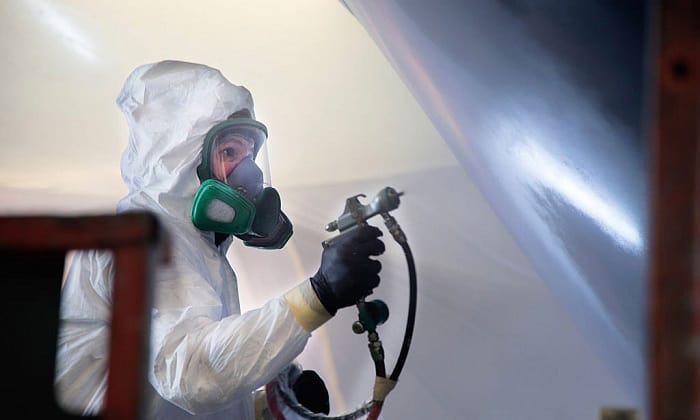
If you follow most of the preliminary preparatory steps I’ve shared here, you will be keeping yourself safe from start to finish.
- Wear the PPEs I said above every time you’re sanding and applying epoxy and paint on the surface.
- Read any warning labels on the paint and other chemicals you use, like acetone for drying the paint quickly. Handle it with care always.
- Learn how to dispose of your paint properly. It’d be even better if you learned how to recycle it.
- Beware of accidents that may happen while you’re doing the cleaning and prep work. I mean, I’ve hit my head on a sailboat mast while doing them, so I reckon the chance of such misfortunes happening isn’t zero, even on a paint job.
To recap everything I’ve said regarding how to paint a sailboat:
- Position your boat in a good workplace.
- Clean and sand its hull well using boat soap and water and sandpaper.
- Apply 4 coats of the primer, 2 coats of the topcoat, then 2 antifouling coats, or skip to the antifouling paint coat immediately.
- Decide how you’re going to apply the paint based on the finish you want and your skill in using each tool.
We wish you the best of luck with your painting project. If you want to share your results with us, feel free to reach out via the comment below.

“My intention from the first day establishing Boating Basics Online is to provide as much help as possible for boaters who want to experience a first safe and convenient trip. So feel free to join us and share your beautiful journeys to the sea!”

- Start Here!
- Art Tutorials
- Art Lessons
Art Supplies
- Shopping Cart

How to Paint a Sailboat Watercolor Painting Tutorial
Sailing is one of my favorite things to do and painting sailboats is almost as fun! This lovely sailboat flew in the wind on Somes Sound on Mount Desert Island, Maine. It was one of those perfect sailing days. The light sparkled, the wind blew steadily and the last of summer heated the air. Since I didn't have a sailboat there, I sketched and took photos of the sailboats moving up and down the Sound.
The shimmering water is the tricky part of this painting. It's a great opportunity to practice your dry brush! This painting needs rough press paper to get that sparkling water. The rest of the painting is simple. Trees in the distance and a pared down palette. Keep the colors and your brush strokes simple. Sailing at its finest on a summer day in Maine!
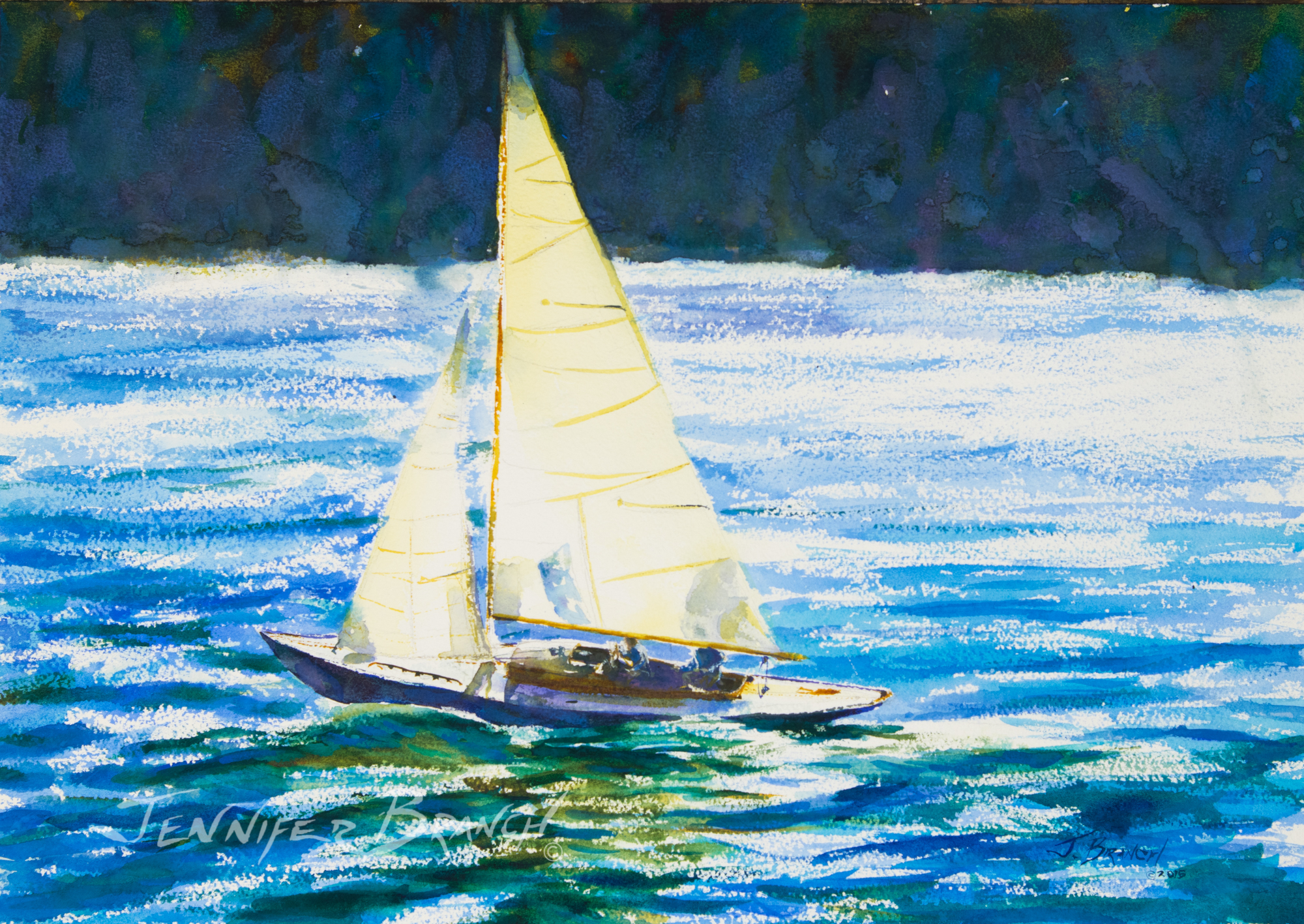
Painting Tutorial Level
Skill Building
M. Graham watercolors
Painting Demonstration 1
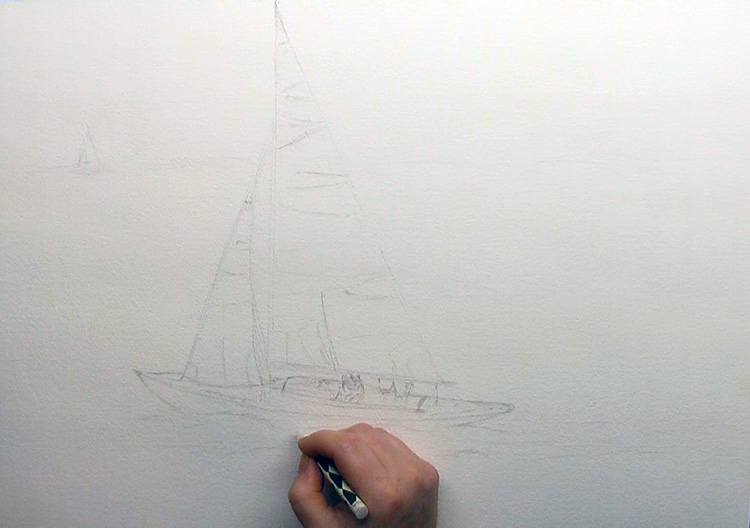
Always sketch very lightly in watercolor since most pencil lines will show. You want the focus on the painting, not the drawing. Unless, of course, you're highlighting the pencil lines!
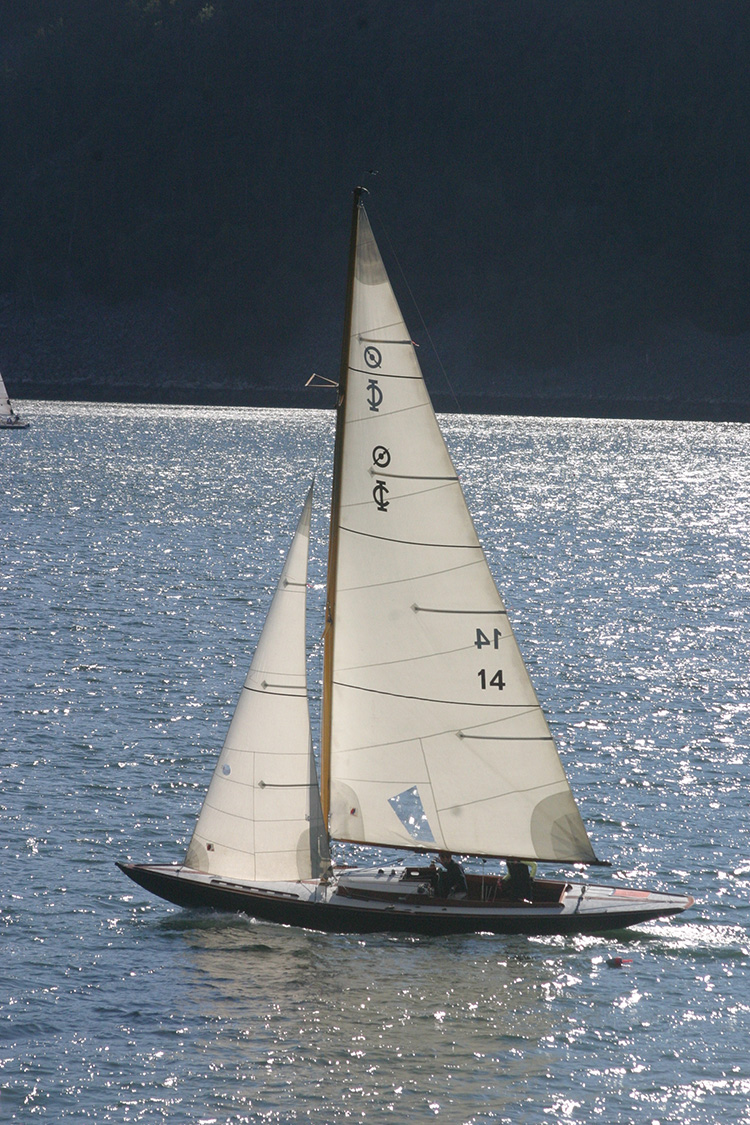
Since I'm painting a light object with a lot of brushstrokes around it (for the water) I can either mask it out, preserve highlights with wax or use white gouache. I decide on a combination of the last two since they feel more spontaneous than masking and I don't have too many bright highlights.
When you use a wax crayon, always remember it's there for better or worse. It will not come off and leave paper the same!
Disclaimer: Jennifer Branch Gallery is a participant in the Amazon Services LLC Associates Program, an affiliate advertising program designed to provide a means for sites to earn advertising fees by advertising and linking to amazon.com. I receive a small rebate for your entire order (starting at 4%) if you choose to purchase through Amazon. Most items can be bought multiple places and I highly recommend local art stores if you have one! Any other recommendation links I receive no compensation for. These referrals help me support this website, and I thank you for any purchase you make through them. I will never recommend a product I have not used frequently and believe is the best tool for the purpose!
Painting Demonstration 2
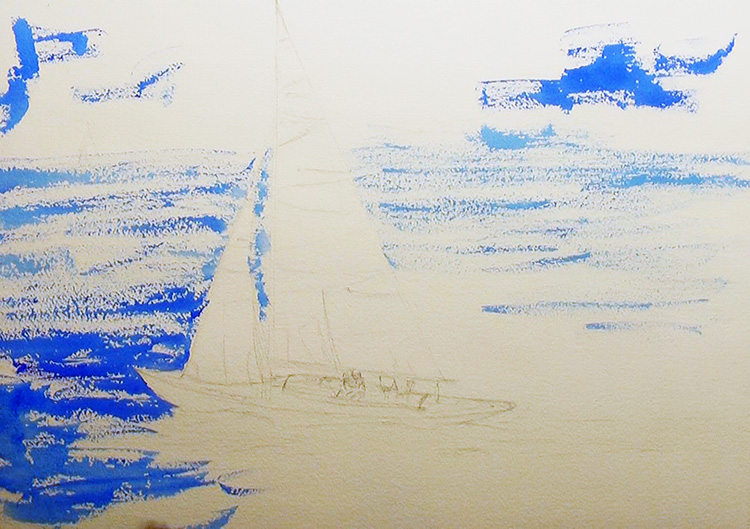
I want barely there water sparkling in the background. Very pale highlights and dark shadows, so dry brush is the solution! Dry brush and texture is why I chose the rough press paper, after all.
With a tricky dry brush where every stroke shows, I like to test the brush a few times on an area of the painting that isn't quite so tricky or a scrap of paper. As you can see, I got the texture just right in the trees at the upper part of the painting. Some extra texture there is perfect and it will be dark enough the individual strokes don't show.
Since all those strokes show up in the water, make them count! Move your brush with the waves. Notice how highlights show up in horizontal swathes across the water. Work with the water, not against it.
A squirrel hair brush is perfect for hit and miss dry brush like this. It barely touches the ridges of the paper so you can really get that sparkle!

Painting Demonstration 3
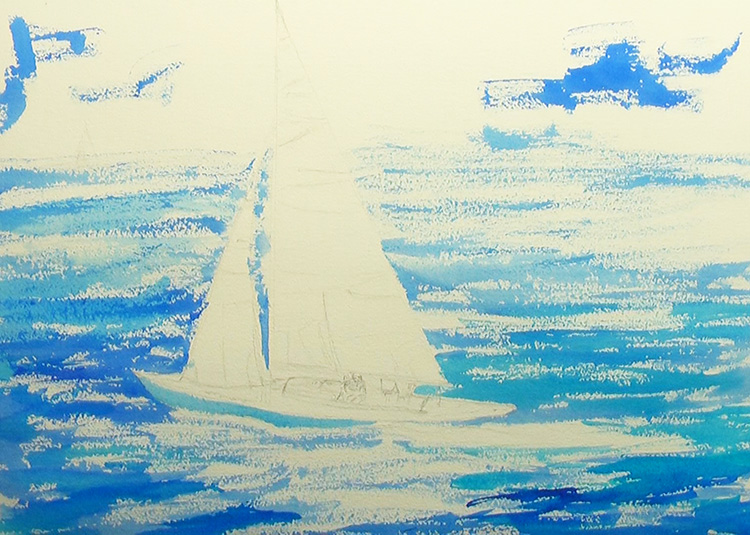
Since this is dry brush, there's no time between washes! I continue moving around the painting, using slightly varying blues and values. This gives me that great water shimmer! If some of the dry brush hits a still wet area, great! that gives a natural feeling variation.
I still keep everything light in value in this wash. I don't want thick sludgy paint, but effervescent sparkle!
Artist Tips
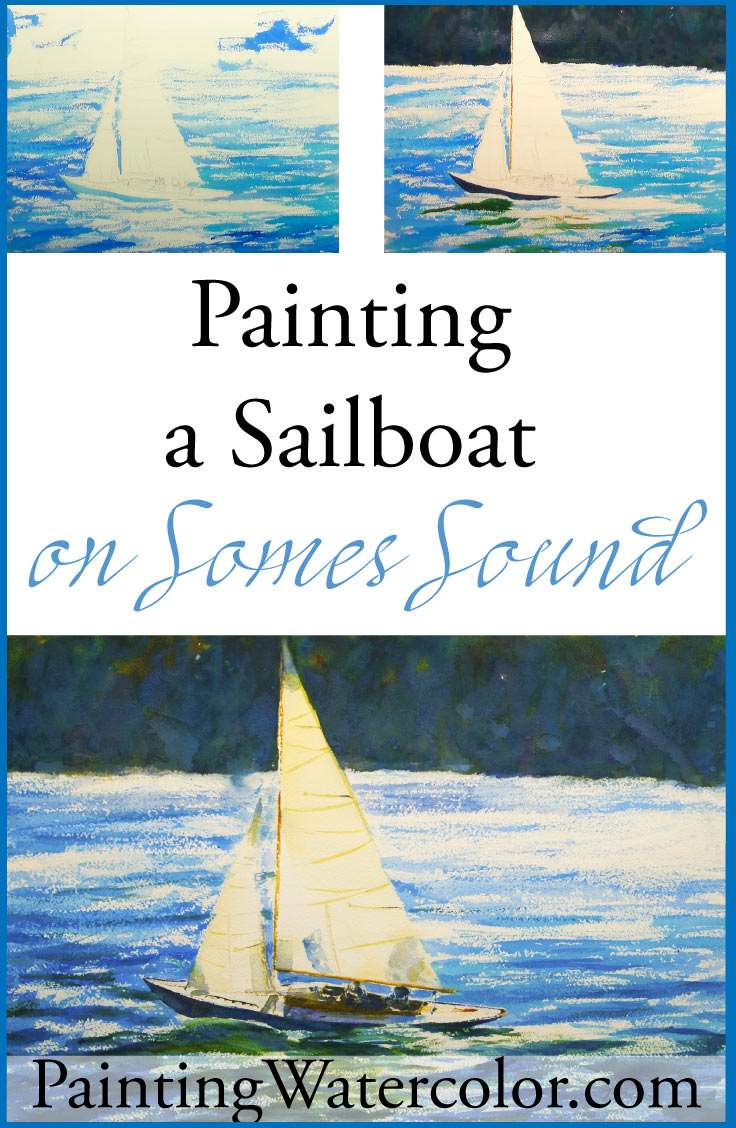
Painting Demonstration 4
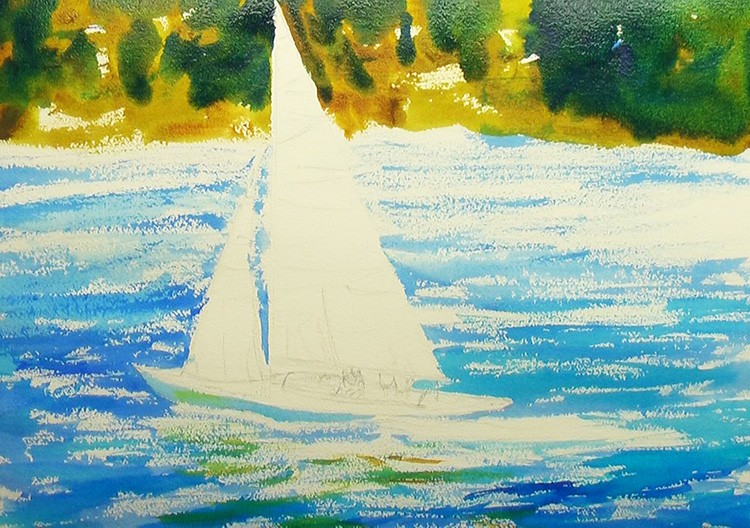
Now that dark background! I want a bit of a a golden glow, but subtle instead of harsh so I use quinacridone gold. This is one of the few paintings I never use a yellow in!
I paint a loose wet brush on dry paper wash of the gold, then drop in pthalocyanine green. I'm keeping it loose since the background is not the focus, the sailboat is!
The reflection of the sailboat is also a golden glow in the water, so I use quinacridone gold again. I'm still painting dry brush since I want the water to sparkle there too, not be dulled. The reflection is also a shadow which makes it quite complicated to paint.
Painting Demonstration 5
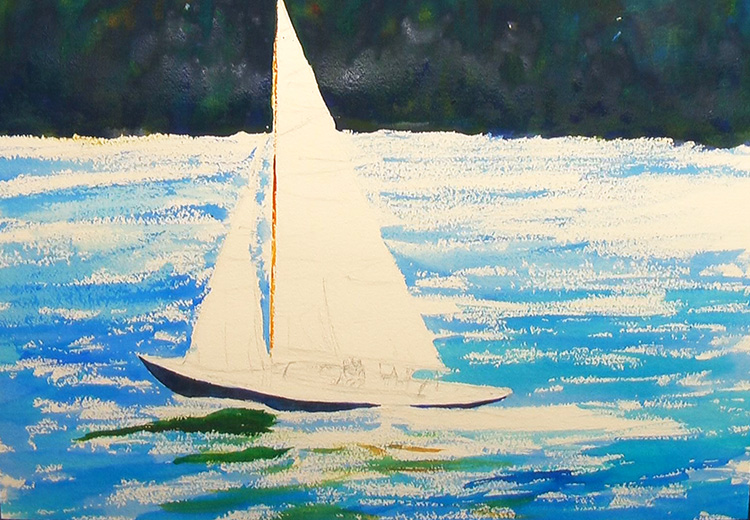
Now it's time to turn the golden green into hazy rich darks. While it's drying, I move maroon perylene into the trees to darken them. The rich red helps with the strong, clear color. Then I scrabble in ultramarine blue to make the trees green again. Finally, I add cobalt blue for the slightly opaque haze.
I dash quinacridone dry brush on the wooden mast. A bit of ultramarine blue and pthalo green gives shape to the boat.
Painting Demonstration 6
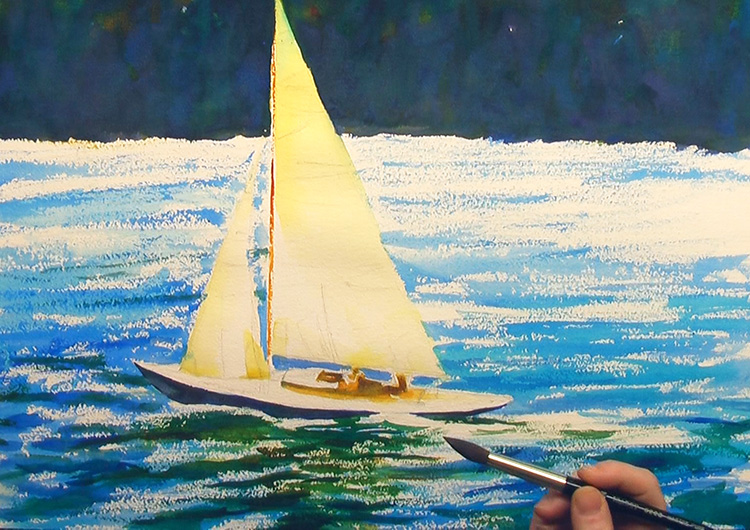
After the painting has dried completely, I start on the sail. The gorgeous sail is really the star of the painting so it's fun to finally start painting it! Still, it has to be kept simple since there really isn't much to the sail. Quinacridone gold gives the faint glow of the reflecting sun.
I continue adding texture and color to the waves. I need strong darks to balance out the background trees.
I keep a light hand on the waves since the lovely shimmering could be destroyed with a few strokes too many!
Painting Demonstration 7

The last stage is the details and it's hard to keep them from getting too fussy!
I continue the details on the sail. I use the top mainsail reinforcement as an excuse to dull down the arrow pointing the viewer out of the painting!

To purchase How to Paint a Sailboat original watercolor painting, please click!
How to Paint a Sailboat Final Watercolor Painting!
Related Art Lessons

- Painting Galleries
- Latitude Pens
- Contact Me!
All Paintings, Images, Videos, Text and Website Design Copyright 2022 by Jennifer Branch. All Rights Reserved. No Image, Video, Text or Website Design may be used without my written, specific permission.
Jenna Rainey

CEO + ARTIST + EDUCATOR

hey friend!
I’m jenna rainey. , i'm an artist, self-taught designer, and multi-faceted creative entrepreneur who is hell-bent on teaching everyone how to find their inner creative voice..
My favorite supplies
A highly creative nerd with a unique breed of humor and the proud earner of a self-bestowed award for being the world’s most curious and driven human.

Hey I'm Jenna!
Hang out on youtube, it’s like netflix-binging bob ross videos, but with a dose of dry + quirky humor and fewer happy little tree references. .

Wanna Learn Watercolor ?
i wrote some books

Master Watercolor magic
GRAB THE FREE GUIDE

Watercolor Sailboat
Jenna .
This week, I'm teaching you how to paint a quick and easy watercolor sailboat landscape!
When I don't have a lot of time or I just want to play with colors and basic shapes, I paint loose-style. It's just whimsical and fun!
This watercolor sailboat takes less than 10 minutes to paint but includes simple techniques to inspire and spark creativity. This is a great tutorial for beginners, too!
Watercolor Sailboat Step by Step
00:00 – Intro. 00:32 – Color mixing. 01:06 – Painting the sail boat. 02:16 – Painting waves. 03:01 – Painting trees and background. 04:53 – Painting the sky. 06:14 – My thoughts on the painting. 06:51 – YOUR thoughts?
Links & Freebies
Get access to all my favorite art supplies and business tools here. My Amazon storefront with supplies and other random things I love. My Spotify painting playlist My Floral Watercolor E-book My Calligraphy E-book
Related videos
Complete Beginner's Guide to Watercolor Complete Beginner's Guide to Watercolor: Top Questions Answered Complete Beginner's Guide to Watercolor Flowers Watercolor Techniques: Wet-on-Wet Watercolor Techniques: Wet-on-Dry 10 Tips to Improve Watercolor
… and for even more tutorials, subscribe to my YouTube channel!
Patreon Community
Join my Patreon community! You have a variety of fun options to choose from like:
- Watch my YouTube tutorials ad-free
- Get early access to the tutorials before they're released on YouTube
- Patreon-exclusive tutorials
Head on over to Patreon to get all the fun details.
by Jenna Rainey
+ show Comments
- Hide Comments
add a comment
Leave a Reply Cancel reply
Your email address will not be published. Required fields are marked *

Browse By Category
art + creativity
So Hot Right Now

Organizing Your Art Space: Tips from an Artist

Starting a New Hobby as an Adult

The Joy of Experimentation: How to Express Yourself Through Different Art Mediums
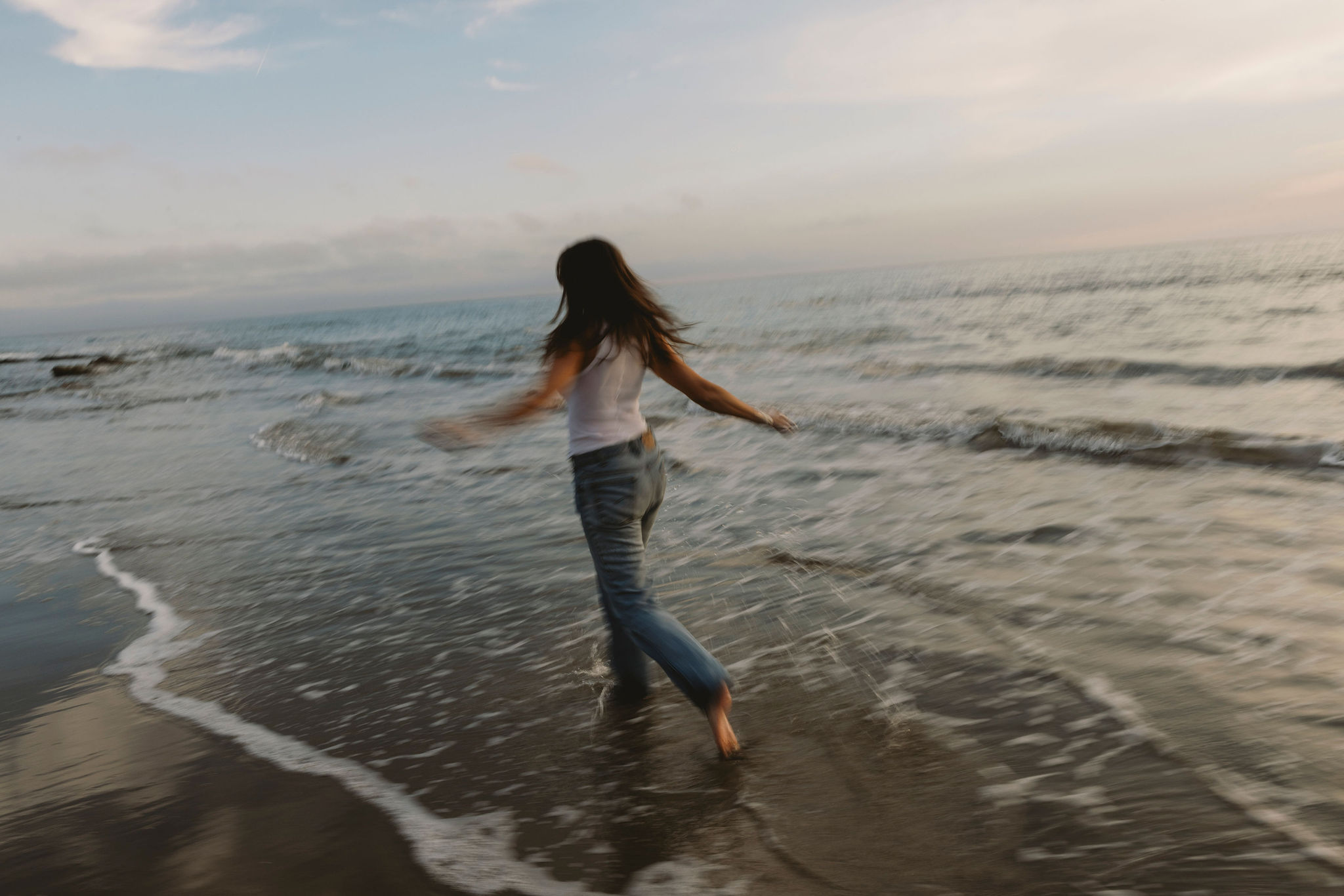
Art and Meditation: 3 Ways You Can Use Art to Enhance Your Meditation Practice

Exploring Abstract Art for Beginner Watercolor Painters
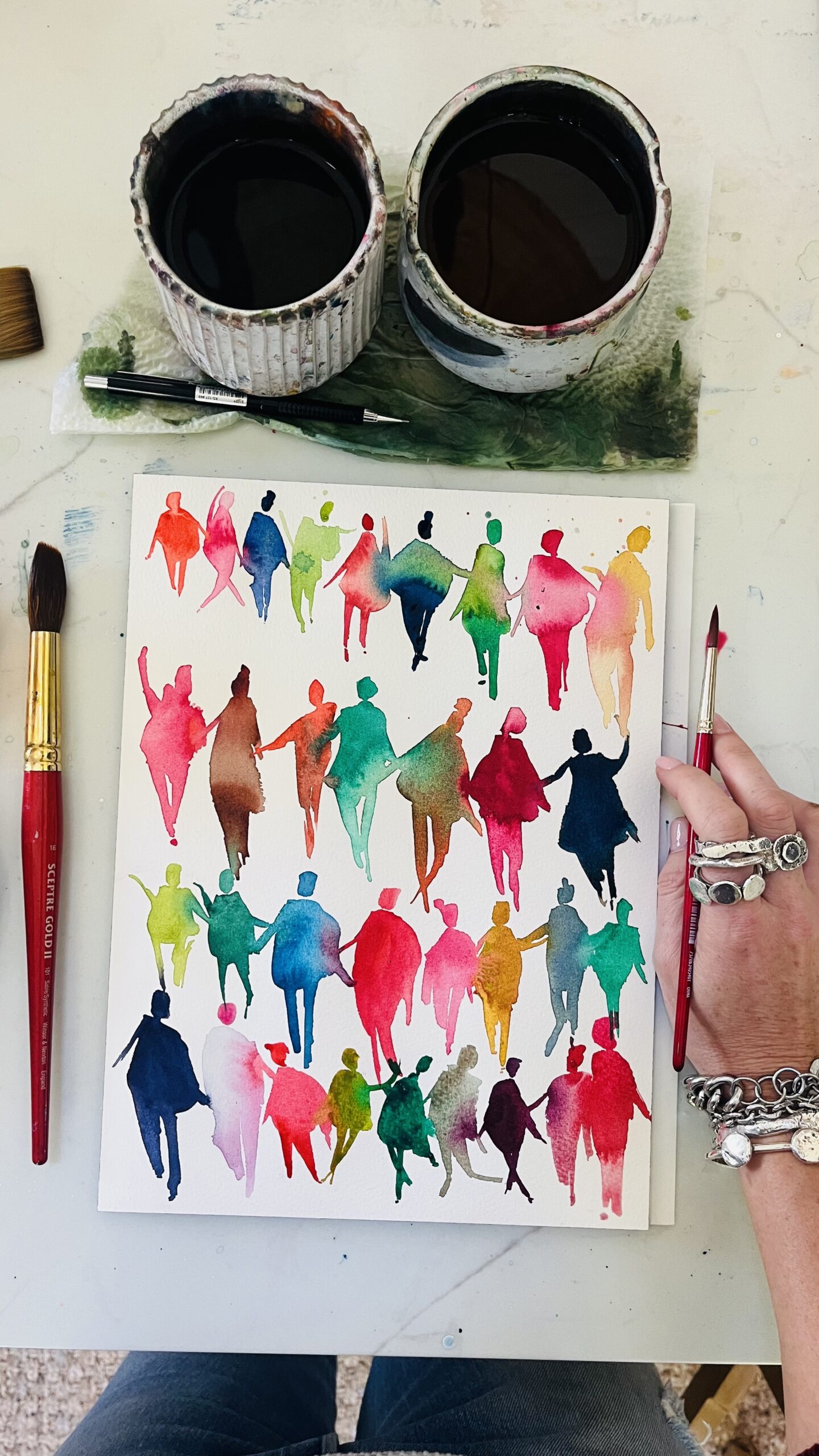
The Connection Between Art and Mental Health
back to blog home
Previous Post
« How to Map Out Your Content Calendar
“Should I Have a Blog?” Reasons Why Blogs Are Important »

The Complete Beginner's Guide to Watercolor
Get a rundown of all my recommended supplies, learn fundamental techniques and tips including color theory and composition, and walk away feeling super confident with your new love of watercolor!

Free e-book
Kickstart your art practice!
*signing up will subscribe you to our email list, you may unsubscribe at any time, though doing so means we cannot contact you with more free, valuable education and tips on this topic. you also agree to our terms and conditions and privacy policy ., an artist, self-taught designer, and multi-faceted creative entrepreneur who is hell-bent on teaching everyone how to find their inner creative voice., i'm jenna rainey..

Customer Support
YOU'VE GOT MAIL!
back to the top

Read the blog
watch me on youtube
my art community
art retreats
everyday watercolor books
licensing resources + tips
The Ceo advice column
Customer service
program login
community login
contact us!
© 2018-2024 JENNA RAINEY LLC | TERMS & CONDITIONS | PRIVACY POLICY | SITE CREDIT

@JENNARAINEY
- BOAT OF THE YEAR
- Newsletters
- Sailboat Reviews
- Boating Safety
- Sails and Rigging
- Maintenance
- Sailing Totem
- Sailor & Galley
- Living Aboard
- Destinations
- Gear & Electronics
- Charter Resources
- Ultimate Boating Giveaway

How to Paint Sailboat Decks
- By Tom Zydler
- Updated: March 14, 2013
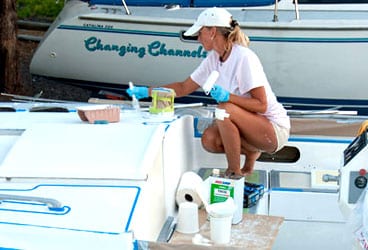
Painting a sailboat
Janet Van Leuwen and Steve Van Wig own a Whitby 42. Looking at their beautiful, well-groomed ketch, you’d never guess it was built in 1982. The name on the stern, Lunacy , may be the only hint of the incredible amount of work that the couple has put into rejuvenating their boat. Bringing the decks and the coachroof top to their present glory was a large part of the project, as these tasks would’ve been on any glass boat more than 25 years old. This is how they did it. And frankly, this is how it should be done.
Before the couple could begin doing any prep work for painting, the deck hardware had to be removed. They needed access to tight spaces where the horizontal deck surface turned into vertical bulwarks, around the masts’ partners, near the windlass base, and so on. (They also removed the chainplates, which needed attention as a separate project.) Out came all stanchions, their bases, various padeyes, winches—anything and everything, in fact, that could obstruct the power sanders required to remove the worn-down, cracking, original nonskid pattern. Steve then used silicon sealant to plug all the fastener holes that would be reused; silicon repels paint, so the fastener locations would be visible when they began reinstalling the hardware.
Donning breathing masks and kneepads, the couple spent days grinding the old surfaces with 80-grit discs. Using thick foam pads on machines running at high rpm prevented any gouging in the laminate. Smaller sanders (both round and square) helped them to negotiate tight turns; at times, they resorted to manual sanding blocks. Working with thickened polyester and epoxy resins, Steve filled several hairline cracks and dings. They then sanded this filler with 80-grit, then 100-grit, and finally 120-grit sandpaper to achieve a smoother surface before vacuuming up all the accumulated dust.
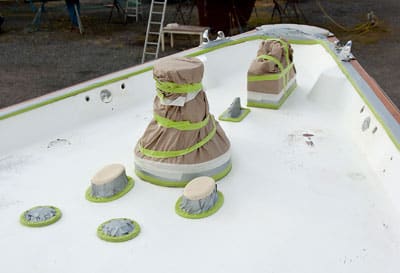
Next, to keep paint drips off teak handrails, the windlass, and the portholes, they masked these with heavy paper and tape. Right after the final wipe with a cleaning solvent, they took two days to roll and brush on two coats of epoxy primer, the base for the final topcoat. Over the next few days, the primed surfaces were sanded with 120-grit paper, followed again by vacuuming and hosing the resulting dust. Afterward, Janet cleaned all the surfaces with non-sticky tack cloths designed for multipart polyurethanes.
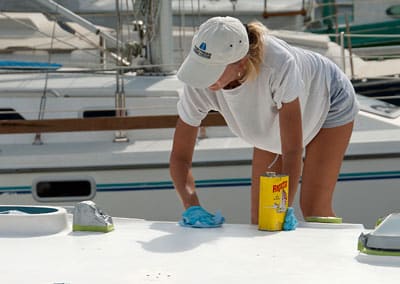
At this juncture, Steve identified and outlined the future nonskid areas, then spent a couple of days taping their inner edges with long-life 3M masking tape. At the corners, joining short lengths of tape on tight curves required meticulous care. After they wiped everything with cleaning solvent, they applied the first coat of multipart polyurethane to all the surfaces outside the future nonskid. Two more topcoat applications followed within allowable, 16-hour intervals. After sanding with 220-grit paper, dusting, using the tack rag, and wiping the solvent, they rolled and brushed on the fourth and final topcoat. The solvent-resistant, ultra-smooth, high-density foam-roller covers and quality brushes delivered the best finish. Working in the hot Florida sun required frequent additions of brushing reducer.
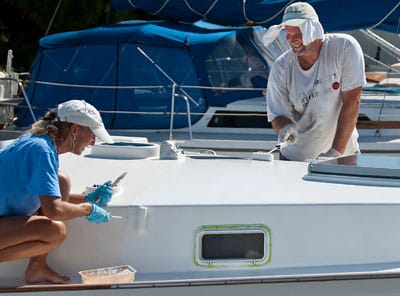
After allowing 48 hours to fully cure, they removed the masking tape. Fresh tape was then applied along the outside margins of the nonskid areas. All was ready for applying the nonskid coats. But first Steve spent a few days experimenting. He mixed his own color tints—too dark, and you couldn’t walk barefoot on the sun-heated deck; too white, and the deck glare was intolerable.
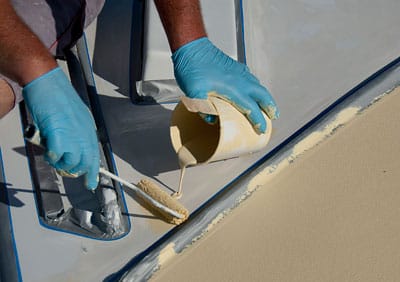
Also, he tested paint combined with various nonskid additives on scrap plywood; very coarse grit could damage human skin if a sailor knelt or fell on deck. He decided to combine equal amounts of coarse and fine grit. Significantly, this mixture prevented the coarse grit from settling down in the paint in lumps. On the big day, Steve and Janet mixed the activator with the paint base in a large container, added the correct nonskid grit, poured in the brushing reducer, and thoroughly stirred it all. After pouring small dollops within a taped area, Steve spread it out with a roller with Janet assisting, adding more paint or grit as necessary. She also wiped up Steve’s occasional paint drips with a solvent-soaked rag. The work went quickly and smoothly, though constant stirring of the paint/grit mixture was absolutely vital.
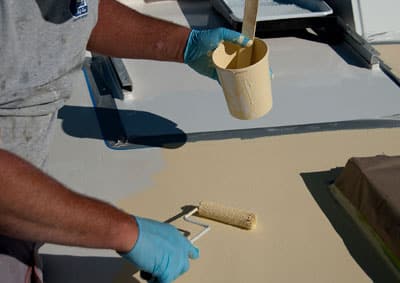
Twenty-four hours passed before heavy, late summer rain rolled in. By then, the paint had cured hard, and the coachroof was finished. They then repeated the whole operation to paint the deck. Nobody said rejuvenating a classic-plastic yacht would be quick or easy. But when the entire project was finished and Lunacy ‘s deck sparkled, the two sailors realized that all their meticulous efforts had been well worth it.
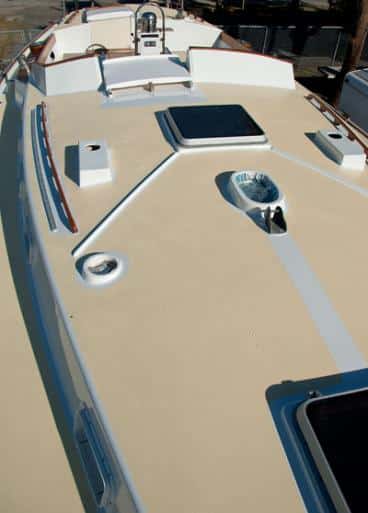
Steps:** 1. In preparation for the job, much of the deck hardware, including the stanchions, had to be removed. The remaining gear was carefully and completely covered and masked. 2. All the fastener holes were filled with silicon sealant, and the couple spent days grinding the old surfaces. Then Janet used a solvent wash to ensure a strong bond with the primer paint. 3. After dings and cracks were repaired and sanded, two coats of epoxy primer were applied. 4. Following another round of sanding, vacuuming, cleaning, and taping, the couple rolled and brushed on a fresh coat of Awlgrip topcoat. 5. After four coats of Awlgrip, it was time for the nonskid. First, Steve experimented with colors and grits. Once under way, he poured on a dollop of pre-mixed paint and spread it evenly. Note the paint stirrer, which was used to prevent the grit from settling. 6. Stirring frequently, to make sure the coverage was even in each masked area, Steve worked quickly and efficiently while Janet addressed small splashes with a solvent-soaked cloth. 7. Voilà! Once the masking tape was removed, the fresh decks fairly glistened.
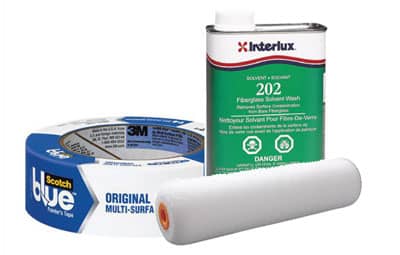
What You’ll Need: • Hook-and-loop sanding discs, sized to fit the sander pads • Sheets of sandpaper of grits 80, 100, 120, 180, 220, and 320 • 3M masking tape in widths of 1/2 inch (No. 256), 1 inch (No. 2090), and 2 inches (No. 225) • Gerson synthetic tack cloths • Roller frames and roller covers, with phenolic cores: ultra-smooth, high-density 4-inch and 6-inch roller covers (available from Home Depot; for the primers and topcoats) and Yellow stripe 3/8-inch nap (from West Marine; for the nonskid paint mixture) • Good-quality varnishing brushes • Cabisil (colloidal silica) thickening agent for making fairing putty with epoxy or polyester resin • Plastic putty knives • Interlux Fiberglass Solvent Wash 202 (for cleaning surfaces) • M.E.K. solvent (for cleaning all brushes) • Disposable paper/plastic pails of various sizes • A dozen wooden paint stirrers • Interlux Epoxy Primekote • Awlgrip topcoat (with Brushing Reducer and brushing converter) • Awlgrip Griptex nonskid additive (fine and coarse grades) • Ryobi and Makita random orbital sanders • Ryobi 6-inch palm polisher (used with a foam pad as a sander in complex spaces) • 3M breathing dust masks, ear protection, and solvent-resistant gloves
Longtime CW contributor Tom Zydler and his wife, Nancy, plan on spending this summer exploring the coast of Labrador aboard their Mason 44, Frances B .
- More: boat maintenance , How To , maintenance
- More How To

Grease the Wheels of Your Boat: A Guide to Proper Lubrication

A Bowsprit Reborn: A DIY Renovation Story

Rigging Redo: Our Switch to Synthetic

Top Tools for Sailboat Cruising: Must-Have Gear for 2024

From Paradise to Medical Emergency: A Bahamas Nightmare Turns Lesson Learned

Free Medical Advice: The Unwarranted, Unprofessional Edition

Gatekeepers of the Waterway

- Digital Edition
- Customer Service
- Privacy Policy
- Terms of Use
- Email Newsletters
- Cruising World
- Sailing World
- Salt Water Sportsman
- Sport Fishing
- Wakeboarding
- New Sailboats
- Sailboats 21-30ft
- Sailboats 31-35ft
- Sailboats 36-40ft
- Sailboats Over 40ft
- Sailboats Under 21feet
- used_sailboats
- Apps and Computer Programs
- Communications
- Fishfinders
- Handheld Electronics
- Plotters MFDS Rradar
- Wind, Speed & Depth Instruments
- Anchoring Mooring
- Running Rigging
- Sails Canvas
- Standing Rigging
- Diesel Engines
- Off Grid Energy
- Cleaning Waxing
- DIY Projects
- Repair, Tools & Materials
- Spare Parts
- Tools & Gadgets
- Cabin Comfort
- Ventilation
- Footwear Apparel
- Foul Weather Gear
- Mailport & PS Advisor
- Inside Practical Sailor Blog
- Activate My Web Access
- Reset Password
- Customer Service

- Free Newsletter

Ericson 41 Used Boat Review

Mason 33 Used Boat Review

Beneteau 311, Catalina 310 and Hunter 326 Used Boat Comparison

Maine Cat 41 Used Boat Review

Tips From A First “Sail” on the ICW

Tillerpilot Tips and Safety Cautions

Best Crimpers and Strippers for Fixing Marine Electrical Connectors

Thinking Through a Solar Power Installation

Getting the Most Out of Older Sails

How (Not) to Tie Your Boat to a Dock

Stopping Mainsheet Twist

Working with High-Tech Ropes

Fuel Lift Pump: Easy DIY Diesel Fuel System Diagnostic and Repair

Ensuring Safe Shorepower

Sinking? Check Your Stuffing Box

The Rain Catcher’s Guide

Boat Repairs for the Technically Illiterate

Boat Maintenance for the Technically Illiterate: Part 1

Whats the Best Way to Restore Clear Plastic Windows?

Mastering Precision Drilling: How to Use Drill Guides

Giving Bugs the Big Goodbye

Galley Gadgets for the Cruising Sailor

Those Extras you Don’t Need But Love to Have

UV Clothing: Is It Worth the Hype?

Preparing Yourself for Solo Sailing

How to Select Crew for a Passage or Delivery

Preparing A Boat to Sail Solo

On Watch: This 60-Year-Old Hinckley Pilot 35 is Also a Working…

On Watch: America’s Cup

On Watch: All Eyes on Europe Sail Racing


Dear Readers

Chafe Protection for Dock Lines
- Inside Practical Sailor
Painting Your Boat Like a Pro
Practical sailor covers topside paints from top to bottom..

After the first round of my complete hull refinish of my 1971 Yankee 30 at Salt Creek Marina in St. Petersburg, FL, I’ve moved on with the more challenging part, the deck refinish. With about 100 hours in the rearview mirror, I’m finally close to removing all of the old monourethane and primer which had completely failed after 8 years. Had the previous owner recoated the boat three years earlier, I likely would have been saved this tedious step.
Although I know I can achieve better results by removing all the deck hardware, I’ve decided not to do this because I’m eager to go sailing this winter while the weather is fine. I figure I’ll touch up around the hardware as I re-bed it in stages over the coming year. This blog post is primarily an overview of the many articles we’ve done on paints and refinishing old hulls, many of which I’ve used to guide my own work.
(Note: One of the easiest ways to peruse our archives on this topic is to search “topside paint” on the Practical Sailor website https://www.practical-sailor.com/?s=topside+paint . Subscribers will see additional links that are not open to the public by going this route — such as our most recent test of non-skid paint. If you will be upgrading your non-skid paint, a search under “non-skid paint” will point you in the right direction ( https://www.practical-sailor.com/?s=nonskid+paint ). And of course, searching bottom paint will yield a vast amount of research ( https://www.practical-sailor.com/?s=bottom+paint )

A high-quality finish begins with proper preparation, and Practical Sailor’ s hands-on refinishing projects on crafts ranging from an 11-foot sailboard to a 41-foot Ericson offered our experts plenty of insight into prep-work challenges. Preparing the hull’s surface for painting is a laborious process, but if you review the primer on prepwork and our do-it-yourself notebook that accompanies our topside paint test, you can save time and avoid the most common pitfalls. If you are set on a do-it-yourself spray paint finish, former technical editor Ralph Naranjo walks you through the process in a sidebar to his extensive, three-year-long topside paint test. These articles offer a good foundation for getting a high-quality finish without shelling out thousands of dollars for a professional paint job.
As Naranjo demonstrates in multiple test boat projects, probably the biggest challenge comes when working with two-part paints. These are usually more sensitive to temperature and humidity than single-part monourethanes or acrylic enamels, which typically are less glossy and less durable than two-part paints. The trick to getting a perfect two-part finish is achieving the right balance of flow and cohesion, so the paint does not sag, run, or orange-peel. This is why we recommend novices undertake a few practice projects like oars or a dinghy before tackling an entire hull.
The quality of your painting tools also makes a difference. For one of our test hulls (a Catalina 22), we used the two-person roll-and-tip method, which entailed one person applying the paint with a roller and the other tipping the rolled-on paint with a brush. If you want to take this route, our article on choosing a paint brush will come in handy. It compares high-quality natural bristle brushes to hardware-store varieties. We also offer a guide to caring for your brushes after using them. And if you plan to save some paint for touch-ups, we have a few tips on preserving leftover paint and varnish .
As the years go by, dulled linear polyurethane (LPU) finishes can be revived, but this requires special care. Our article on extending LPU life makes sure you avoid any mis-steps that can lead to premature LPU death.
We’ve recently made open to the public our introduction article to the ongoing test of topside finishes. Presently, only subscribers can review our latest test report on topside paint .
For even more detailed advice on sailboat refinishing, check out Don Casey’s illustrated guide Sailboat Refinishing, which covers everything from choosing the right tools to getting a professional finish at half the cost. The book is available in our online bookstore . And if youre not interested in painting your hull but simply want to bring back its shine, our e-book on gelcoat restoration and maintenance tells you everything you need to know about reviving a worn fiberglass hull.
We’d like to hear about your hands-on experiences during do-it-yourself paint projects. If you have already undertaken a paint project, you can help fellow sailors through this process by posting your comment below or emailing our editorial offices at [email protected] .
RELATED ARTICLES MORE FROM AUTHOR
On watch: this 60-year-old hinckley pilot 35 is also a working girl.
I recently repainted my trawler yacht using Epifanes mono urethane. The gloss was amazing. I used the roll and tip method. I struggled to get the fine brush marks to lay down and disappear. After conversing with the Canadian rep he informed me they now just recommend rolling, without the tipping off. They now recommend rolling over spraying as well! My final coat was done that way and the results were great. I have used Epiphanes competitor products (Interlux and Petit) with much worse results. In one case I painted a racing sloop 4 separate times and it glossed up only one of the four times. In another case a barrier coat litterally balled up and would not roll on pulling itself off as I rolled. Epifanes for me! You can see my video of the results on a facebook page I manage “Mainship Owners Page”
I am hauling out in a month or so in Mid Florida. Having played with car painting , I was astonished at a video showing someone use a rattle can of Rust-Oleum and then atop that , a rattle can of clear two-part polyurethane. On the bottom of the polyurethane clear is a button one presses to puncture the smaller of the two inside Chambers thereby mixing the two-part polyurethane clear. The results were incredible! Because I am a poor person, that is how I’m going to paint my 30 foot hunter cherubini.
I painted (SOLO) the deck of my boat the first half of August, 2020 in an open boatyard contending with wind, rain, periodic bird droppings, morning dew, and rotating around the boat from the hot sun when possible. Given the environmental challenges I changed my mind from Interlux Perfection to Interlux Brightside. I followed the manufacturers instructions to the letter (I must have called them four times with questions) and very satisfied with the results thus far. I did two coats of both primer and topcoat (roll and tip method) with all the sanding measures recommended. I did not remove (strip) all deck equipment before painting…removal and reinstall would have added another two weeks as the deck of my 42′ cutter is very busy with four hatches, five dorads, numerous blocks, and many other equipment placements. I only painted the smooth parts of the deck, not the nonskid sections. Thus, the massive taping portion of the job took me 1.5 days alone matching the original deck layout. Sanding, vacuuming, and wipe-down between each coat…essentially, one day of prep then one day of painting was the routine. The large open deck/cockpit portions were relatively easy and went quickly but painting around detailed gear made the task more difficult.
It was a job that badly needed to be done and, overall, I am glad it is over and pleased with the job but it was a lot of work working solo.
Our boating co-op which at the time I was fleet captain, had 5 Catalina 27’. We used a two part product by Pacific Endura. Foam rollers with no tipping ended up the best application. One needed a magnifying glass to see some orange peel which we wet sanded most of down to a great finish. A very tough product needing some practice to get right. The company has excellent help available.
When I painted my Pearson 36, I used Epifanes two component. As I was rolling and tipping, I noticed that some spots due to lack of space were only getting hit with the brush. When I saw how smooth and glossy those spots looked, I decided to to a little test.
I was planning on painting two coats. So the first coat, I painted the starboard topsides, rolling and tipping. I painted the portside, rolling only. I painted the transom with the brush only.
I am not a pro by any means, but the roller only side looked better than the rolled and tipped side and the brush only transom.
Is it the paint? I am planning on painting the boat again due to scratches, but the previous paint job is holding up well and looks great from 10 feet away.
The correct roller material (mohair) makes a huge difference, as well as having the paint at the right temperature, thinned correctly and having a helper move the scaffolding and mix the paint so the applier doesn’t have to stop.
I was going to use the epithhane paint as well. But they recommended a foam roller. Did you try the foam roller or was the mohair better than that Could you please respond to my email at [email protected] or text 610 662 1694 Thanks Marty
I’ve used several two part paints with roll and tip and pretty good results. However, Alexseal with their recently introduced brushing additive is far more forgiving that other paints. I mix it 2:1:1 with converter and reducer then apply it with a mohair mini-roller. Rather than tipping with a second brush (or second person) and go over it lightly with the same roller shortly after if necessary to pop any bubbles. However, there are very few.
In addition, the paint is repairable, meaning that it can be buffed out and blended without later differences in appearance. No matter how good you are, there is gonna be some %$@! bug in the paint, and picking it out after the solvents have flashed off will always leave a defect. Likewise with dust and Maryland oak pollen.
Spraying a two part paint in clean conditions might give you a nearly perfect finish, but the isocyanate mist reaches hazardous levels before you can smell any solvents through an ill-fitting respirator. Thats why the Safety Data Sheet tells you to use an external air setup that few DIY painters will invest in.
I strongly second Jim Kneale’s recommendation for Alexseal. The brushing additive means you can just roll it out with no tipping. It has totally changed the game for DIY painters. I am just finishing up a hull repaint using Alexseal in Pasadena, MD. The most common question I get from fellow boaters and professionals alike is “I assume you sprayed that?”
Another advantage is the ability to apply multiple coats without sanding in between, if applied with 12 hours. At 70+ degrees I’ve been overcoating after 90 minutes.
I have an extensive journal on this project if anyone wants details: https://potomacboatcraft.com/projects/hull/2020-07-01-overview.html
LEAVE A REPLY Cancel reply
Log in to leave a comment
Latest Videos

What’s the Best Sailboats for Beginners?

Why Does A Sailboat Keel Fall Off?

The Perfect Family Sailboat! Hunter 27-2 – Boat Review

Pettit EZ-Poxy – How to Paint a Boat
Latest sailboat review.

- Privacy Policy
- Do Not Sell My Personal Information
- Online Account Activation
- Privacy Manager

Please verify you are a human
Access to this page has been denied because we believe you are using automation tools to browse the website.
This may happen as a result of the following:
- Javascript is disabled or blocked by an extension (ad blockers for example)
- Your browser does not support cookies
Please make sure that Javascript and cookies are enabled on your browser and that you are not blocking them from loading.
Reference ID: 9a5e05f8-6610-11ef-a6f5-379efbc559c8
Powered by PerimeterX , Inc.

Sailboat Bottom Paint: 10 Best Paints

Last Updated by
Daniel Wade
June 15, 2022
If you leave your boat without protection, it's beyond question that it will start attracting several marine organisms such as slime, algae, mussels, barnacle, and seaweed. This will cover the bottom of your sailboat and may negatively affect your boat's speed and fuel efficiency.
This is exactly why you need to apply the best sailboat bottom paint on your boat.
The freedom that sailing and being off land gives you are immense and almost unmatched.
But do you know that having multiple organisms such as algae, slime, barnacle, seaweed, and mussels grow on your boat can throw everything out on the wind and leave you with a very unreliable boat?
These pesky hangers will put a huge dent in your boat's speed, its movement, fuel efficiency, and overall aesthetic.
That's why you need the best sailboat bottom paint to greatly minimize any damage that might be caused to your boat's hull by marine biological growth.
Also known as antifouling paint, bottom paint is essentially a paint or coating that's specifically designed with elements that prevent various marine organisms such as algae, seaweed, barnacles, slime, and mussels from attaching themselves to your boat's hull or any other part of the boat that's below the waterline.
One of the most important elements of bottom paint is the inclusion of a biocide and copper is the most common. This may, however, depend on the type of boat that you have, how, and where you always use it.
But because there's an ocean of bottom paints out there on the market, choosing the best sailboat bottom paint can be an overwhelming task for most of us.
Fortunately, you can always count on us to make it a lot easier for you. We've gone through many bottom paints and we do not doubt that we've selected the most effective, reliable, and best sailboat bottom paint.
Our unbiased selections will not only match your needs and budget but will be available in a variety of colors to complement and augment your boat's visual appeal.
Table of contents
What to Consider when Purchasing Sailboat Bottom Paint
If you're on the market for the best sailboat bottom paint, it's crucial to go for top quality; something that will offer efficiency, top speed, and excellent performance for your sailboat. With that in mind, here are a few things to consider before spending your hard-earned money on bottom paint.
Your Sailing Location
Where are you planning to sail? Is it on a freshwater body or in a saltwater location? This is essential in helping you determine whether to go for a bottom paint that's meant for saltwater, freshwater, or both. It's generally recommended that you go for a bottom paint that will serve you perfectly well in both freshwater and saltwater. This gives you the versatility of sailing anywhere without worrying about marine organisms damaging your boat's hull.
Launch Time and Recoat Time
It's important to keep in mind that bottom paint products have specific launch time limits. The idea here is to ensure that you launch it within the required timeframe and ensure that recoating is done as required. You should, therefore, choose a bottom paint that offers a lengthy launch and recoat time while offering durable protection for your vessel is the right thing to do.
Type of Boat
You should determine whether your boat is made of wood, fiberglass, or aluminum and go for bottom paint that's suitable for that particular surface. Many bottom paints work perfectly with fiberglass but some work great with aluminum or wooden surfaces.
The Fouling Condition
Having a deeper idea of the type of fouling that you might deal with can be crucial when buying the right bottom paint for you. Whether you're dealing with slime, algae, mussel, or any other type of marine organism, knowing the type of fouling you're dealing with will make it a lot easier to pick the best sailboat bottom paint for your vessel.
Best Sailboat Bottom Paint
Rust-oleum marine flat boat bottom antifouling paint.
As one of the most respected brand names in the bottom paint industry, Rust-Oleum is known for producing some of the best sailboat bottom paint and the Marine Flat Boat Bottom Antifouling Paint is one of them. This bottom pain is designed to be suitable for various conditions (both freshwater and saltwater) and is designed with moderate copper that works great if you are environment-conscious.
This bottom paint does an excellent job of offering a protective coating to ensure that your boat is free of all sorts of unwanted marine organisms. You'll love this paint because it is thick and spreads so easily and will not be a problem even if you're a beginner. This bottom paint offers top-notch antifouling properties and is very easy to apply as long as you use a soft brush and mix it carefully. This is a great bottom paint choice that will offer a sleek multi-season finish and ensure that your boat's hull is always awesome and in great condition.
- Easy and simple to apply
- Great for both freshwater and saltwater
- Offers gentle fouling conditions
- Excellent in antifouling
- Offer a sleek and awesome finish
- Quite expensive
- Has a very strong smell that can cause headache
Interlux Fiberglass Bottomkote Antifouling Paint
This is another great brand that is considered as one of the best bottom paint in the sailing world. Even though it's a bit pricey, it offers great features that will ensure that your boat remains in tip-top shape. It is an excellent option if you're looking for a sailboat bottom paint that brings to the fore a unique dual resin approach.
This is a very reliable bottom paint that will not only prevent your boat's hull from the effect of marine organisms but also prevent premature deterioration. It offers an awesome polishing action and is perfecting if you want to discard unnecessary paint buildup. This bottom paint is also very economical and a small quantity will cover a considerable surface area of your boat's bottom.
This is, without a doubt, a superb buy in terms of its practicality and economical nature. It is excellently formulated to prevent marine organisms from damaging your boat and also to ensure that premature wear and tear doesn't exist in your vocabulary.
- It's formulated with a unique dual resin approach to prevent premature wear and tear
- It prevents early decline
- It prevents unnecessary paint buildup
- Great for ensuring that your boat is fuel effective
- Great for all conditions (both freshwater and saltwater)
- It's expensive
- The quantity and size can be misleading
TotalBoat JD Select Bottom Paint
As one of the few bottom paints that's formulated with low Volatile Organic Compounds (VOC), this bottom paint is one of the most cost-effective on this list. With one gallon, you can easily cover about 400 square feet and the application is a breeze since it's even much easier to clean up.
When you purchase this bottom paint, the package will come complete with a pair of latex gloves, a wooden stir stick, an abrasive pad, a metal tray kit, a paint suit, a roller, a painter's tape, and many more. The inclusion of all these accessories makes it a quite cost-effective purchase.
Again, this is one of the most durable bottom paints. Apply it on your boat's hull and you're guaranteed that it will offer excellent protection for the next 18 months. On the downside, this paint is too thick and you'll have to buy an excellent thinner for it to work perfectly.
Nonetheless, this is an ablative bottom paint that is easy to apply and does an excellent job of protecting your boat's bottom for close to two years.
- Perfect for all conditions
- Easy to apply and clean up
- Can improve your boat's speed and fuel efficiency
- Comes with all accessories required for the paint job
- It's one of the best water-based bottom paint products in the industry
- It contains low VOC
- You'll need a top-quality thinner for it to work perfectly
Aquaguard Water-based Antifouling Bottom Paint
An excellent choice for both wooden and fiberglass boats, this is the most perfect bottom point for saltwater conditions. This is a water-based bottom paint that's very easy to apply and clean up (using soap and water) and is formulated with an ablative action that makes it superb for preventing any marine organism that may negatively affect your boat.
This is a bottom paint that is EPA-approved and surpasses the set VOC standards. It has an extended shelf life and offers durable protection for your sailboat. It doesn't contain toxic fumes and is great even for novices. Its drying time is also excellent, so you won't wait for far too long to get your boat out there on the water.
- Excellent for saltwater conditions
- Application and cleaning is very easy
- It's approved by the US EPA
- You don't have to use a primer
- The color selection is limited
- A bit pricey
Pettit Hydrocoat
This is another water-based bottom paint that offers outstanding ablative properties that will protect your boat from marine organisms throughout the seasons. It offers good value for money and is easy to apply and clean up with just water and soap.
We're talking about a bottom paint product that will protect your boat's hull for months on end. You also do not need a full tank of the paint to complete the job. With just a single gallon, you can be sure to complete an area as big as 430 square feet.
This is also one of the few bottom paints that can perfectly prevent your boat from damage when being trailered, launched, or beached. More importantly, it's not irritating to the nose and eyes because it has low VOC.
- It will dry in 3 hours
- It's easy to apply and clean up
- It offers multi-season protection
- It's not irritating to the eyes and nose
- It's quite economical
- May not be the best in antifouling
- You have to apply at least two coats
SEA HAWK PAINTS Aluminum Boat Paint
One of the best aluminum boat paints in the market, this bottom paint is formulated to offer quick-dry corrosion-blocking, high-solid features. This bottom paint is specifically manufactured to be used in aluminum boats and doesn't require the addition of any primer.
While it doesn't have an antifouling feature, it stands out and can be used both below and above the waterline as it is risk-free and free or chromate. It is also formulated to offer a unique dual resin approach and can be used both as paint and a primer at the same time.
This is a great paint for both freshwater and saltwater conditions and can be applied as a primer or topcoat on a fiberglass boat. This is an excellent sailboat boat bottom paint that's worth every coin as it is practical, versatile, and can combat both rusting and lifting.
- The application and cleanup process is easy
- Great for both freshwater and saltwater conditions
- It doesn't require a primer
- Can be used as primer or topcoat in fiberglass boats
- Can prevent rusting and lifting
- It has quick-dry and anti-corrosion features
- Can produce deadly fumes
TotalBoat Spartan Boat Bottom Paint
If you've been looking for a practical, reliable, and cost-effecting bottom paint that will offer durable performance and protection, the Spartan Boat Bottom Paint. Perfect for both freshwater and saltwater, it can be perfect for protecting your boat and ensuring that it is fuel-efficient and reliable.
This bottom paint is formulated with advanced copolymer ablative to ensure that it doesn't deteriorate instantly. This is a very dependable bottom paint that will serve you perfectly throughout the year and will ensure that your boat easily defies fouling while reducing unnecessary buildup and sanding on your boat.
This is a very adaptable bottom paint that not only offers great value for money but is very easy to apply. More importantly, it is very durable and will protect your vessel for at least 12 months on any type of water.
- Great for all types of water
- It offers a very durable protection
- Available in a wide variety of color selection
- Offer a visually appealing abrasion-proof finish
- The included accessories aren't up to the right quality
To this end, we must put a lot of emphasis on the importance of having the right bottom paint for your boat. In addition to being an antifouling agent, bottom paint will significantly increase the fuel efficiency of your boat and ensure that it performs optimally at all times. Of course, you do not want to diminish your sailing escapades or have your nice and beautiful vessel damaged by marine organisms just because you didn't apply the right sailboat bottom paint. If you're unsure how to proceed, here's how to paint a sailboat.
Related Articles
I've personally had thousands of questions about sailing and sailboats over the years. As I learn and experience sailing, and the community, I share the answers that work and make sense to me, here on Life of Sailing.
by this author
Repairs and Maintenance
Sailboat Upgrades
Most Recent

What Does "Sailing By The Lee" Mean?
October 3, 2023

The Best Sailing Schools And Programs: Reviews & Ratings
September 26, 2023
Important Legal Info
Lifeofsailing.com is a participant in the Amazon Services LLC Associates Program, an affiliate advertising program designed to provide a means for sites to earn advertising fees by advertising and linking to Amazon. This site also participates in other affiliate programs and is compensated for referring traffic and business to these companies.
Similar Posts

How To Choose The Right Sailing Instructor
August 16, 2023

Cost To Sail Around The World
May 16, 2023

Small Sailboat Sizes: A Complete Guide
October 30, 2022
Popular Posts

Best Liveaboard Catamaran Sailboats
December 28, 2023

Can a Novice Sail Around the World?
Elizabeth O'Malley

4 Best Electric Outboard Motors

How Long Did It Take The Vikings To Sail To England?

10 Best Sailboat Brands (And Why)
December 20, 2023

7 Best Places To Liveaboard A Sailboat
Get the best sailing content.
Top Rated Posts
Lifeofsailing.com is a participant in the Amazon Services LLC Associates Program, an affiliate advertising program designed to provide a means for sites to earn advertising fees by advertising and linking to Amazon. This site also participates in other affiliate programs and is compensated for referring traffic and business to these companies. (866) 342-SAIL
© 2024 Life of Sailing Email: [email protected] Address: 11816 Inwood Rd #3024 Dallas, TX 75244 Disclaimer Privacy Policy
New state-of-the-art patrol and dive boat to enhance Etowah County safety
by JEFF COX

ETOWAH COUNTY, Ala. (WBMA)—The Etowah County Sheriff's Office will receive hundreds of thousands of federal dollars to fund new projects.
In a press release, Etowah County Sheriff Jonathon Horton credits U.S. Senator Katie Britt (R-Ala.) with securing $300,000 for his department. Horton says the money will fund upgrades to their public safety equipment, including a new patrol and dive boat to aid their Marine and Dive unit in covering the county's 437 miles of shoreline.
"Waterways often create additional challenges for law enforcement to keep everyone safe," Horton said. "This $300,000 would upgrade public safety equipment with the purchase of a patrol and dive boat. This would help Etowah County Sheriff's Office better protect local families and communities year-round."
Britt says securing this funding was a top priority for her.
"Ensuring our tremendous law enforcement officers have the best tools to protect their fellow Alabamians and themselves is a top priority for me," said Senator Britt.
Horton says the boat will be state-of-the-art with technology including live-scan sonar, adding that feature will help enhance his Marine and Dive unit's capabilities.
"This new vessel will significantly improve our ability to serve Etowah County citizens and the broader region by ensuring safer and more efficient waterway recoveries," Horton said. "We extend our sincere appreciation to Senator Britt for her instrumental role in securing these funds."

The 2024 Fall Boats Afloat Show
Thu, september 12, 2024 — sun, september 15, 2024.

The Northwest’s largest on-the-water boating showcase, the 2024 Fall Boats Afloat Show docks at Seattle’s South Lake Union September 12-15 spotlighting more than 125 impressive motor yachts, a variety of sailboat offerings, high-end cruisers ideal for Northwest waters, high-performance craft, fishing models and much more. Presented by the Northwest Yacht Brokers Association (NYBA) since 1978, this boating tradition offers opportunities to learn, dream and explore the latest boating lifestyle and technology trends.
The show features marine services and the Dockside Marketplace offering high-quality boating-inspired goods, clothing and art; informational seminars; family-friendly activities (the show is free for children 12 and under); a raffle supporting Salmon For Soldiers; casual dining and beverage options and live music performances by top local talent each day of the show.
New this year, the Opening Day Ticket (Thursday, September 12) includes the ticketholder’s choice of a wine, beer or non-alcoholic beverage in price of the discounted $20 ticket (available online-only at boatsafloatshow.com ), redeemable at the Breakwater Bar.
Women's Day (Friday, September 13) celebrates women’s growing involvement in boating. All are welcome, but women can purchase discounted tickets - $10 online or $11 at the door; valid for admission on Friday, September 13.
Show hours are Thursday and Friday (September 12-13), 11 a.m. to 6 p.m.; Saturday (September 14), 10 a.m. to 6 p.m. and Sunday (September 15), 10 a.m. to 5 p.m. Admission is $22 for adults 18 and over, $5 for teens ages 13-17, and is free for children 12 and under. Tickets can also be purchased through the show’s website including discounted adult tickets ($20) and a multi-day “All Access Pass” for $35, available exclusively online at boatsafloatshow.com.
For more information visit www.boatsafloatshow.com . The 2024 Fall Boats Afloat Show is located at Lake Union Piers on the shores of South Lake Union at 901 Fairview Ave N, Seattle, WA 98109 .
Event Details
Recommended Ages
- http://www.boatsafloatshow.com
Event Type:
- Exhibitions ,
- Other Great Stuff ,
- Outdoor Fun
Latest + Greatest

Seasonal Fun
Top seattle-area family activities for september 2024.

City Adventures
Seattle aquarium’s new ocean pavilion.

Big Kids Away, Tots Will Play

Kids + Media
Powerful books to read during banned books week.
The 12 best places to visit in Tyumen (the oldest siberian city)
It is the oldest city in siberia and has many points of interest. find out about the best places to visit in tyumen, russia..

The first Siberian city was founded in 1586. Tyumen has been unofficially titled the oil and gas capital of Russia. The city’s population is 707 000 people, which continues to increase. According to RBC Holding, Tyumen is one of ten the most quick-growing towns in Russia. Don’t let the mention of oil-hungry businesspeople leave you thinking this is a dull, money-focused city, though. The city has a buzzing street life in summer and a couple of worthwhile sights that, taken together, will keep you entertained for a day or so.
Tyumen is also the stepping stone to the gorgeous old town of Tobolsk, a few hours’ bus or train ride away. Tyumen is a cultural, business, educational and administrative center of the Tyumen region. Most of the city’s population comprises young people under 35.
Here are always places to go in the evening and to see during weekends. Cozy cafes, luxurious restaurants, the best theatres and philharmonic concert hall, and museums reminding about the rich history of the city — all that is Tyumen. These are the best places to see in Tyumen, Russia.
1. Tyumen’s Holy Trinity Monastery

Tyumen’s Holy Trinity Monastery is located in the historical center of Tyumen. It is just a few minutes walk from the Tura Embankment. The monastery was founded on the picturesque bank of the Tura River in 1616. Almost a century later, in 1708, the old wooden monastery was rebuilt with stone. Shortly after, the monastery was named Holy Trinity. The building process was conducted under the leadership of metropolitan Philophey Leschinsky. Later, he took monastic vows and lived in seclusion for the rest of his life. After he died in 1727, he was buried at the monastery’s entrance.
During the Soviet period, the monastery was used as a dormitory for a military platoon and the headquarters of the city’s water control system. The monastery was returned to the Tyumen diocese in 1995, but the first service was not held there until 2003. In 2005 the relic of prelate Philophey was uncovered and is now kept in the Peter and Paul Cathedral monastery. In 2007 a square was dedicated to Philophey near the monastery. Today Holy Trinity Monastery is open for everyone to see and tour while it continues to hold regular liturgical services.
2. Znamensky Cathedral

The history of Znamensky Cathedral found its roots in the first half of the 17th century, when a small wooden chapel was first erected at the site of the current Cathedral. The old wooden chapel was replaced with the construction of a stone church which began on September 1st, 1768. The church’s previous name was given in honor of Mary, the Mother of God, and her icon within the church. The building was dedicated only 33 years later, in 1801. The church’s first stone building was painted white and consisted of the main chapel, a bell tower, a refectory, and a porch.
After the Revolution of 1917, the Cathedral was used as a transit prison. Still, between 1933 and 1941, the church was returned to the diocese. With the beginning of World War II, however, it was again taken over and used to house dislocated army forces. Finally, the Cathedral was returned to the eparchy. On June 19th, 1994, the clergy held a liturgical service for the first time. Today Znamensky Cathedral is a functioning church and one of the most beautiful symbols of Tyumen.
3. Tyumen Bolshoi Drama Theater

In 2008, The Tyumen Bolshoi Drama Theater got a new building built in record time for one year and eight months. With a 158-year history, the theater is the most prominent Drama Theater in Russia. The history of the Tyumen theater began even before the first building. It is known that in 1858 the St. Petersburg guest expressed his admiration for Amateur performances.
This fact was recorded, and the city’s theatrical history was reckoned from it. History tells us that in 1890, the first Guild merchant, an honorary citizen of the municipality Tekut’ev Andrei Ivanovich, founded a permanent theatre, which entered the town history called Tekut’evsky. Andrei Ivanovich, in love with the spectacle of dramatic scenes, supported theatre for 26 years.
In 1916, before his death, he bequeathed the theatre to the city. The City Council accepted the gift, and newspaper announcements began to inform about the performances not in the Tekut’ev’s theater but in the city theatre named Tekut’ev. After the October revolution, the theatre received the name of V. I. Lenin.
Under the leadership of the Petrograd director Valmar, it was staged such performances as “Idiot”, “the Power of Darkness”, “the Living corpse”, and “the Day”. In subsequent years the core of the repertoire included Russian and foreign classics, the best works of modern drama.
4. Saint George Ascension church

Through the parishioners’ efforts, this church was erected on the Tura River’s left bank. The church began as a stone two-storied building with a bell tower and two thrones: one is on the first floor in honor of Saint George and the other in honor of the Ascension of God is on the second.
After the October Revolution in 1929, the church was closed, and a workshop of tanners and chemists used its building. In 1934-35 the church became a dormitory for driving school students and combined operators. Later the building was under the governance of Tuymen’s fur coat fabric company.
Only in 1996 was the building returned to the diocese of Tobolsk and Tyumen. Two years later, services were resumed there. Step by step, in 2005, the bell tower was restored. In 2006, the church participated in the government program entitled “Cultural memorials restoration.” Now it is a functioning church that adorns the historical center of Tyumen.
5. Church of the Saviour

The Church of the Saviour, also known as the Church of the Image of “The Saviour Not Made by Hands” or shorter Spasskaya Church, is a church in Tyumen, Tyumen Oblast, Russia, located at Lenin Street, 43, at a crossroad between the Chelyuskintsev Street. Built-in a late 18th-century Siberian Baroque and early 20th-century neorussian style, the building is one of Siberia’s oldest and most expressive churches, under monument protection.
It is believed that the early wooden church was raised in 1586 and reconstructed after several fires into a stable stone building in the late 17th century. The Church of the Saviour saw another two rebuildings in the late 19th century. However, after the 1917 October Revolution, the church was subject to confiscations of its property in 1922, and in 1930 was closed and became a momentary prison.
After the failed attempt to destroy the church two years later, it has been used as an archive and a library. The building storage material for the Tyumen Local Historical Museum is expected to be returned to the local eparchy in 2019.
6. Tura Embankment

The only thing in the Russian four-level structure of this kind and one of the favorite holiday destinations among residents and visitors alike. Here, close to each other is full of the city’s attractions: Lover’s Bridge, historical area, the museum “City Council” Architecture and Construction University, and Holy Trinity Monastery. Embankment and bridge of lovers – the city card is depicted on the magnets, postcards, and other souvenirs tourists bring from Tyumen.
Construction of the promenade continues today, and it planned its expansion on both sides of the river Tura. Throughout the embankment, scattered monuments of famous people, life, and activity were somehow linked to Tyumen. Summer, early Fall, and spring – are the best time for walking and spending time on the waterfront.
It is always noisy: many people are playing songs with a guitar, working fountains, flash mobs, and holding various events, to the bridge of lovers traditionally come to the newlyweds. In the summer promenade Tours – the most popular holiday destination for residents.
7. The Lovers’ Bridge

The Lovers’ Bridge is a cable-stayed bridge over the Tura River in the Central District of Tyumen. The bridge was built in 1987 – five years after the collapse of an old wooden bridge in the exact location. The last name of the bridge was Peshehodniy (Pedestrian). Still, in 2003 local DJs Maria Kondratovich and Timur Shkval arranged an unusual contest called “The most unusual kiss”.
After this event, the city mayor Stepan Kirichuk offered to rename the bridge the Lovers’ Bridge. Then, on July 26th, newly married couples, the director of the Red Army Radio Station V. Bogodelov, and the city’s mayor performed an official ribbon-cutting ceremony to commemorate the bridge.
8. Kolokolnikovs Estate Museum

The Kolokolnikovs Estate Museum is the only remaining classical merchant’s estate in Tyumen. The building’s facade combines classical and baroque architecture elements and traditional Siberian carving. The doors open to a luxurious, brightly lit hall with lofted ceilings and walls decorated with vivid paintings of the Kolokolnikovs family.
One painting depicts an old trade shop, representing the collective image of the city’s shops. Stepping through the doors of the Kolokolnikovs Estate transports one back to the unique atmosphere of the late 19th and early 20th centuries.
The permanent exhibit of the Kolokolnikovs Estate Museum is called “The History of the House”. It is dedicated to the history of the merchant families, such as the Ikonnikovs and the Kolokolnikovs. The exhibit will also explain the historical events in this house, one of which was the monumental meeting between the future Emperor Alexander II and the great Russian poet V. Zhukovsky in 1837. In 1919 the estate was used as the headquarters of Marshal V. Blyukher.
9. Gorodskaya Duma Museum

The building of the Tyumen regional Museum of Local Lore Gorodskaya Duma was built in the second half of the XIX century. It is a magnificent example of Russian provincial architecture. The high ladder and a stepped attic give the museum its slenderness, combined with a Corinthian portico and massive columns — the traditional buildings of public institutions and architectural elements.
The Window into the nature constant exhibition introduces the variety of Flora and Fauna of the Tyumen region and its ancient inhabitants. An integral part of the museum is a small paleontological Museum. The skeleton’s collection of mammoth, fossil bison, woolly rhinoceros, and cave bears is presented at the museum. In addition, visitors can get acquainted with the Botanical, Zoological, and entomological collections.
10. House Masharova Museum

The House Masharova Museum is an old house built in the neoclassical style and previously belonged to N. Masharov, a famous manufacturer and one of the founders of the iron industry in Tyumen. The museum is a monument to late 19th and early 20th-century Siberian architecture and is renowned for its luxurious décor.
Traditional musical events and temporary exhibitions are regularly organized in the House Masharova Museum. They take place in the chamber-like atmosphere of the welcoming hall of the merchant’s house.
The permanent exhibition called the Family Book tells the tale of the family’s life at the end of the 19th century. During a tour of the house built, you will see many authentic items of a past era and discover the etiquette of a traditional family from Tyumen.
11. Alexandrovsky Garden
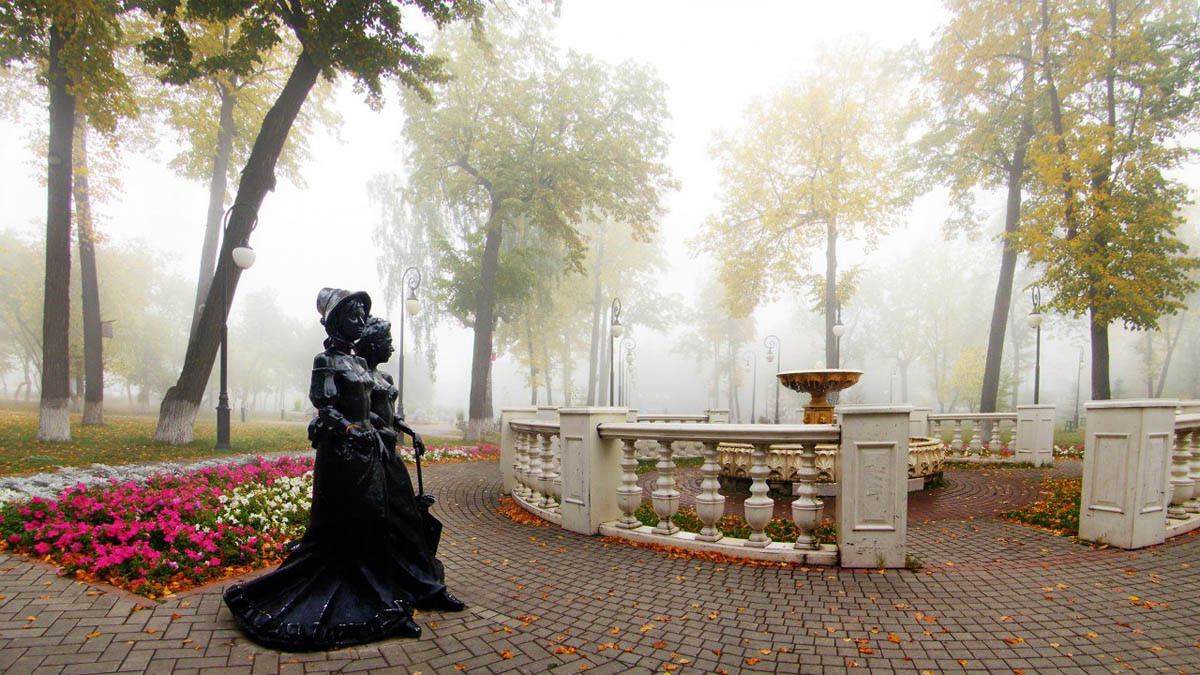
The original name of the Alexandrovsky Garden is the Country Garden. The garden appeared on a vacant plot of land in 1851 when thousands of linden, birch, spruce, and pine trees were planted in the area of about 100 acres (40 000 m²) with the money of the merchant Ivan Ikonnikov.
The garden was named after the crown prince Alexander, the future Tsar Alexander II, who visited Tyumen on May 31st, 1837, during his journey through Siberia. After the October Revolution of 1917, the garden was abandoned until 1948, when a small portion of it was restored through the employees’ efforts of a ship-building plant.
The landscape of the garden was adorned with a pond, a small bridge built traversing the ravine, a shooting range, and a restaurant with a terrace. In the 1960s, it was abandoned again, and by the 1970s, it fell into disrepair. Later a development effort began on the garden’s premises with the construction of houses, a kindergarten, and garages. A road to the Profsoyuzny Bridge was also built through the park.
However, the renewal of the garden did not begin until 2007. Although ten times smaller than the original garden, the grounds were restored, and the Alexandrovsky Garden became its official name. The fountain was rebuilt as well as sculptures of citizens styled after the 19th century. Some statues include the Hussar, Ladies on a Walk, A Girl at Rest, and the Boy.
12. Rasputin Museum

Grigory Rasputin was a friend of the last Russian emperor Nikolay II and his family. Rasputin is one of the most mysterious and exciting personalities of the end of the 19th and the beginning of the 20th centuries. In the 1900s, among Saint Petersburg’s high society, he had the reputation of the Tsar’s family friend, a religious elder, a seer, and a healer.
The exposition includes a cosmetic mirror, broken down in the middle that symbolizes the broken life of its owner, an icon of St. Simeon Verhotursky the Righteous, who is highly honored in Siberia, and the plate of the famous Kuznetsovky porcelain factory with the monogram of the empress, which Rasputin gave to his god-daughter Iraida Kolesnikova during her christening, an old Viennese chair from the Rasputin’s house. There is an authentic platband from the famous home of Rasputin, and the only thing remained of the building.
Leave a Reply Cancel reply
Your email address will not be published. Required fields are marked *
Save my name, email, and website in this browser for the next time I comment.
Notify me of follow-up comments by email.
Notify me of new posts by email.

Portuguese pastry: 15 amazing sweets from Portugal
There are few countries in the world with as much variety of traditional sweets as Portugal. The immense variety of...

Russian cities: the 15 largest

The most common Russian names (meanings and origins)

100 amazing Fyodor Dostoevsky quotes full of wisdom

30 Russian Proverbs and Sayings full of wisdom
© 2024 Vortex Magazine
Mais infomação
Redes sociais.

IMAGES
VIDEO
COMMENTS
It is important to keep your boat well painted as it can save you a lot of money in the long run, especially if you paint your boat yourself.
Hello my creative friends! In this acrylic painting tutorial we will go step by step to learn how to paint a sailboat in the ocean. Thank you to my awesome p...
In today's acrylic painting tutorial we paint a sailboat out on the ocean at sunset. This relaxed painting lesson is done in real time and will cover the ste...
Started by some of the legends of the wooden boat world like Maynard Bray, Ben Mendlowitz, and Bill Mayher, we also feature experts like Harry Bryan, Russell Brown, Geoff Kerr, Brian Larkin, and more.
Whether you're maintaining the topsides of a wooden classic or covering up old, faded gelcoat, the same prep and boat paint techniques apply.
Explore sailboat painting techniques and tips to transform your vessel. Elevate your sailing experience with vibrant hues.
Are you excited but intimidated to learn how to paint a sailboat? Let me gently walk you through the whole process.
Free watercolor painting tutorials! Painting sailboats is almost as much fun as sailing them! YouTube video and step by step instructions on painting a beautiful sailboat on sparkling water! Watercolor Painting Tutorial by artist Jennifer Branch
This week, I'm teaching you how to paint a quick and easy watercolor sailboat landscape! When I don't have a lot of time or I just want to play with colors and basic shapes, I paint loose-style. It's just whimsical and fun! This watercolor sailboat takes less than 10 minutes to paint but includes simple techniques to inspire and spark creativity.
New Life for Old Decks: A fresh coat of deck paint on your vintage classic-plastic cruiser will make the old gal sparkle and shine.
A high-quality finish begins with proper preparation, and Practical Sailor' s hands-on refinishing projects on crafts ranging from an 11-foot sailboard to a 41-foot Ericson offered our experts plenty of insight into prep-work challenges. Preparing the hull's surface for painting is a laborious process, but if you review the primer on ...
Visit West Marine for helpful videos, advice on bottom paint selection, step-by-step instructions and other expert tips on how to bottom paint a boat.
Rust-Oleum Marine Flat Boat Bottom Antifouling Paint. As one of the most respected brand names in the bottom paint industry, Rust-Oleum is known for producing some of the best sailboat bottom paint and the Marine Flat Boat Bottom Antifouling Paint is one of them. This bottom pain is designed to be suitable for various conditions (both ...
This video shows how to paint a sailing boat in watercolor. It´s simple and easy, for beginners. Get my drawing book: http://amzn.to/1K7L8EdFollow my Instagr...
Choose your favorite sailboat paintings from 23,599 available designs. Featuring all kinds of sailboats, from sloops to schooners and yachts to yawls, this collection of paintings has something for everyone. These pieces of art invoke deep emotion with pictures of stormy weather, sleepy harbors and majestic, three-masted ships. With so many different styles and motifs to choose from, sailing ...
Check out our sailboat paintings selection for the very best in unique or custom, handmade pieces from our prints shops.
Another body has been brought to shore as Italian authorities continue to search for the six missing people from the "Bayesian" superyacht that sank off the coast of Sicily. Four bodies were ...
"Waterways often create additional challenges for law enforcement to keep everyone safe," Horton said. "This $300,000 would upgrade public safety equipment with the purchase of a patrol and dive boat.
The Northwest's largest on-the-water boating showcase, the 2024 Fall Boats Afloat Show docks at Seattle's South Lake Union September 12-15 spotlighting more than 125 impressive motor yachts, a variety of sailboat offerings, high-end cruisers ideal for Northwest waters, high-performance craft, fishing models and much more. Presented by the Northwest Yacht Brokers Association (NYBA) since ...
Aug 28, 2024 - Looking to get inspired on your trip to Tyumen? Immerse yourself into world-class art, exciting history, and mind-bending science. Check out the best museums in Tyumen to visit in 2024. Book effortlessly online with Tripadvisor!
Learn how to paint a sailboat scene in this, step by step, acrylic painting tutorial with artist Ashley Krieger.
Top Tyumen Oblast Paint & Pottery Studios: See reviews and photos of Paint & Pottery Studios in Tyumen Oblast, Russia on Tripadvisor.
The boat recently received a new paint scheme, and it looks like it was getting its sea legs back as crews took it for a spin on the east side of the Lagoon to test functionality. The FriendShip IV has a similar, but inverse paint scheme to the FriendShip VIII. FriendShip VIII passes in front of the United Kingdom Pavilion (Aug. 2024)
Things to Do in Tyumen, Russia: See Tripadvisor's 21,366 traveller reviews and photos of Tyumen tourist attractions. Find what to do today, this weekend, or in August. We have reviews of the best places to see in Tyumen. Visit top-rated & must-see attractions.
The building's facade combines classical and baroque architecture elements and traditional Siberian carving. The doors open to a luxurious, brightly lit hall with lofted ceilings and walls decorated with vivid paintings of the Kolokolnikovs family. One painting depicts an old trade shop, representing the collective image of the city's shops.
Hello my creative friends! In this acrylic painting tutorial we will go step by step to learn how to paint a sailboat with a sunset over the ocean. Thank you...
The crew of Mike Lynch's superyacht had 16 minutes to avoid the tragedy, the chief executive of the firm that built the boat has claimed. Giovanni Costantino, the founder and chief executive of ...
Painting for First-time or Beginner painter: Simple Sailboat Please LIKE👍this video, SUBSCRIBE to the channel & SHARE with your community🎨Support Paint wi...
"The public knew of submarines as the silent deadly killers, the death toll they left behind was huge and now they were face to face with one", said Alice Roberts-Pratt, senior curator at Hastings ...